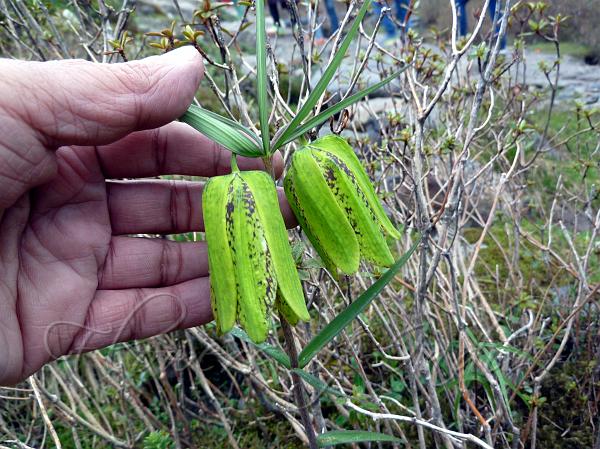|
| Himalayan Fritillary |
|

|

| File size | 765839 |
| Original date | 6/10/16 12:56 PM |
| Resolution | 2560 x 1920 |
| Flash | Flash did not fire, auto |
| Focal length | 4.1mm |
| Exposure time | 1/30s |
| Aperture | 3.3 |
| Focus Distance | |
| Metering Mode | Multi-segment |
| Camera make | Panasonic |
| Camera model | DMC-TZ10 |
| Sensor type | OneChipColorArea |
|
|
|
|
Photo: |
Botanical name: Fritillaria cirrhosa Family: Liliaceae (Lily family)
Synonyms: Fritillaria roylei, Fritillaria polyphylla, Fritillaria zhufenensis
Synonyms: Fritillaria roylei, Fritillaria polyphylla, Fritillaria zhufenensis
Himalayan Fritillary Himalayan Fritillary is
a perennial herb found high in the Himalayas. Stems are 15-60 cm
tall. Oppositely arranged leaves, 7-11 in number, are sometimes also 3-
or 4-whorled and alternate. Leaves are linear to linear- lanceshaped, 4-12
cm long, 3-5 mm wide, with the tip often curved or coiled. Flowers are
borne in groups of 1-3, subtended by 3 leaflike bracts. Flower are yellow,
nodding, bell-shaped. Flower stalk is much shorter than the tepals. Tepals
are yellowish-green to to brownish-purple, slightly or heavily spotted with purple,
usually oblong-elliptic, 3-5 × 1.2-1.8 cm. Stamens are 2-3 cm long;
style is 3-lobed. Capsule is narrowly winged. Yellow Himalayan Fritillary
is found in alpine thickets, meadows, flood lands and moist places in the
Himalayas, at altitudes of 3200-4600 m, in NE India. Flowering: May-July.
Medicinal uses: The bulb is supposedly antiasthmatic,
antirheumatic, febrifuge, galactogogue, haemostatic, ophthalmic and
oxytocic. It is boiled with orange peel and used in the treatment of TB
and asthma.
The bulb is supposedly antiasthmatic,
antirheumatic, febrifuge, galactogogue, haemostatic, ophthalmic and
oxytocic. It is boiled with orange peel and used in the treatment of TB
and asthma.
Medicinal uses:
 The bulb is supposedly antiasthmatic,
antirheumatic, febrifuge, galactogogue, haemostatic, ophthalmic and
oxytocic. It is boiled with orange peel and used in the treatment of TB
and asthma.
The bulb is supposedly antiasthmatic,
antirheumatic, febrifuge, galactogogue, haemostatic, ophthalmic and
oxytocic. It is boiled with orange peel and used in the treatment of TB
and asthma. | Identification credit: Pankaj Kumar | Photographed at Tsomgo lake, Sikkim, Rohtang Pass, Himachal Pradesh & Gulmarg, Kashmir. |
• Is this flower misidentified? If yes,